Gutter Guards
Gutter guards can be an important addition to your home, saving time and money spent on gutter cleaning, while protecting and extending the life of your gutters. Without gutter guards installed, leaves collect in your gutters blocking the proper flow of water and defeating the purpose of the gutters. Wet leaves and standing water add a tremendous amount of weight to the gutters which may stress the gutter hangers to the breaking point. If water trapped in the gutters freezes it can expand, damaging the gutters and causing leaks. These leaks often result in decaying fascia board and soffit. Well designed and properly installed gutter guards can be an effective solution to these problems.
A common misconception is that rain washes your gutters full of leaves, and it is true that some leaves are carried into the gutters during heavy rains. The reality is that most leaves find their way into the gutters when it is not raining. As leaves fall on the roof, wind and gravity conspire to move them ever lower until they reach the edge of the roof and slip into the unprotected gutter. By the time it rains the gutters are already mostly full of leaves. When rain water rushes into the gutter it soaks the leaves compacting them and pushing them into the downspouts until they are clogged. To maintain the proper flow of water it is often necessary to clean out unprotected gutters three or more times each year.
Properly functioning gutter guards divert leaves off the gutter on dry days and when it rains the majority of debris is diverted off the gutters while most of the rain is carried into the gutters. The small amount of debris that winds up in the gutter is insufficient to cause blockage and is easily flushed out as the gutter drains.
Most gutter guards slip under the shingles and fit over the top of the gutters. In theory they allow water to flow into the gutters while diverting the leaves past the gutters and onto the ground below. In practical application though many brands are somewhat lacking.
Types of Gutter Guards
Although there are dozens of different styles and manufacturers of gutter guards they can all be placed into a few categories.
- Slotted, punched hole and screen systems all employ a similar strategy of attempting to
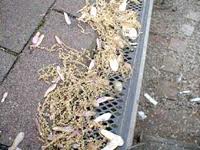 filter leaves and twigs that wash off the roof. This design has a flaw in that the perforations in the surface catch and trap leaves. Not only do the trapped leaves look unsightly but they may actually hold moisture against the roof resulting in decay of the roof sheeting or fascia boards Many of these types of gutter guards are also very flimsy and easily crushed or blown out of place. Stay away from this style to avoid disappointment later on.
filter leaves and twigs that wash off the roof. This design has a flaw in that the perforations in the surface catch and trap leaves. Not only do the trapped leaves look unsightly but they may actually hold moisture against the roof resulting in decay of the roof sheeting or fascia boards Many of these types of gutter guards are also very flimsy and easily crushed or blown out of place. Stay away from this style to avoid disappointment later on.
- In gutter systems are among some of the poorest designed gutter guard products and
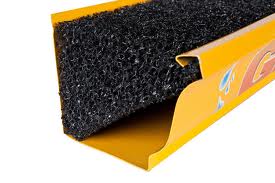 should more aptly be called leaf traps or dirt traps. They are generally of two styles, the first consisting of some type of foam or mat that fits down into the gutter. The idea being that if the gutter is full of foam there is no room for leaves. The second style is the bottle brush which as the name
should more aptly be called leaf traps or dirt traps. They are generally of two styles, the first consisting of some type of foam or mat that fits down into the gutter. The idea being that if the gutter is full of foam there is no room for leaves. The second style is the bottle brush which as the name 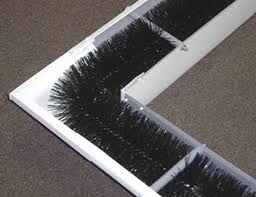 suggests looks like an over sized bottle brush laying in the gutter. Both types trap leaves, twigs, dirt and the small stones that wash off the roof. It is not uncommon for seeds to germinate and start to grow among the fibers of this type product. These styles may also trap and hold moisture against the roof or fascia. In my experience these types of gutter guards create more problems than they solve.
suggests looks like an over sized bottle brush laying in the gutter. Both types trap leaves, twigs, dirt and the small stones that wash off the roof. It is not uncommon for seeds to germinate and start to grow among the fibers of this type product. These styles may also trap and hold moisture against the roof or fascia. In my experience these types of gutter guards create more problems than they solve.
- Micro mesh covers are highly rated as being one of the most efficient gutter guard
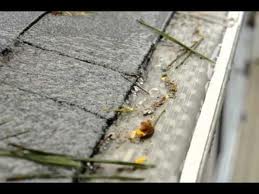 products on the market. With solid construction and a thoughtful design, this style gutters guard is what you might expect if you invest a lot of money in research and development. Newly installed this system works extremely well. Over time however, the extremely fine screen mesh becomes clogged with debris and mildew rendering it much less effective. This system will provide good service when new but requires frequent cleaning as it ages and is also venerable to screen puncture. The main drawbacks to this system are the necessity for frequent cleaning and the exorbitant cost.
products on the market. With solid construction and a thoughtful design, this style gutters guard is what you might expect if you invest a lot of money in research and development. Newly installed this system works extremely well. Over time however, the extremely fine screen mesh becomes clogged with debris and mildew rendering it much less effective. This system will provide good service when new but requires frequent cleaning as it ages and is also venerable to screen puncture. The main drawbacks to this system are the necessity for frequent cleaning and the exorbitant cost.
- Reverse curve gutter guards have been around for a long time and all work on the same principal. The adhesive properties of water, sometimes referred to as water tension, causes rain water to follow the curved outer lip of the cover back into the gutter while leaves and other debris are directed over the edge of the gutter and onto the ground. Reverse curve systems, produced in both
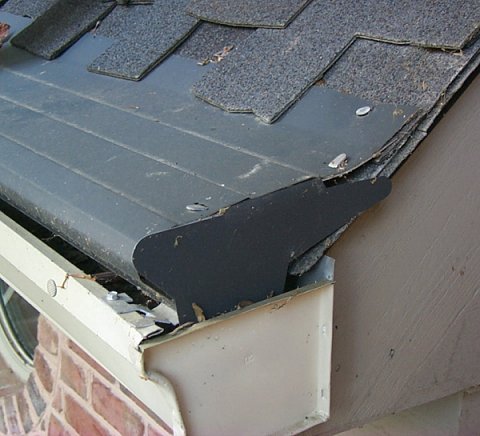
The Gutter helmet works well
but it’s bulky & unsightlyaluminum and vinyl, use this simple and efficient design that works well as long as a means of properly securing the individual pieces to the gutter is provided. Clips, brackets and straps are some of the methods used for securing the aluminum products. Some of the aluminum gutter guards, such as the “gutter helmet”, work well but are extremely bulky and unsightly. Vinyl gutter guards employ a continuous locking lip that is durable yet easy to remove and replace if needed.
I have installed, repaired, replaced or removed most types of gutter guards over the years leaving me with some good insight and strong views on the pros and cons of each style. While no gutter guard preforms perfectly in all applications, reverse curve systems offer the best compromise between cost and efficiency, with the vinyl style being my preference. Reasonable materials and labor costs, an efficient design and a low profile that blends in with the gutter make vinyl gutter guards a good choice.
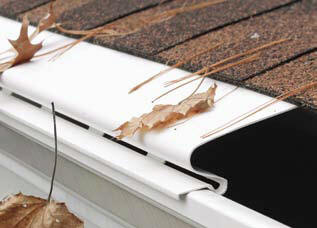
vinyl gutter guards provide an
affordable and efficient design
Did you enjoy this post? Tell us what you think in the comments box below.
Want to see more?
Subscribe to our RSS feed or Subscribe by e-mail
Wood’s Home Maintenance Service installs and repairs gutters and gutter guards. Contact us today for a free estimate.



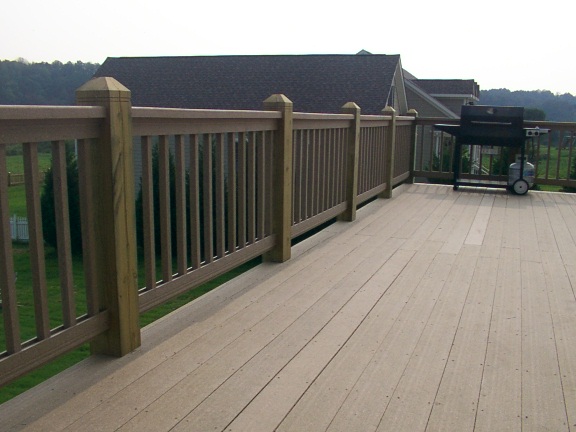

I’m concerned with the durability factor on these “PVC Gutter-guards” since I live in the state of Minnesota where winters get plenty cold.
The PVC thickness appears to be roughly 1/8″; therefore, is there a good chance for this product to crack in the cold, windy weather?
Jim,
I only have experience with them in the triangle area of NC, where they have proven to be durable and perform very well. Once they are in place they are very secure on the gutter. I don’t think the wind will affect them at all and while PVC does get brittle in cold weather it only tends to break if subjected to sudden impact or excessive bending, neither of which should occur on your gutters. If you are concerned about the suitability of vinyl gutter guards for your area, you might install a few pieces for a test run before doing the entire house. Good Luck!
I live in rural south Georgia, can I buy the gutter guards from you and install myself ? If so send pricing.
Thank you for contacting WHMS concerning gutter guards. Installing gutter guards is one of the many services we offer our clients, however we are not a distributor. There are several local vendors that we purchase from. You can find information on one of the brands that I like by clicking on this WaterFall gutter guard system link.
This is some really good information about gutter covers. I liked the reverse curve systems and agree that the gutter helmet is a bit too unsightly for my taste.
This is some really good information about gutter guards. It is good to know that there are a few different types of gutter guards. It seems like it would be smart to think about getting reverse curved cards. That does seem like it would help prevent leaves from getting stuck.
I just moved into a house that has a lot of maple trees near the house. I have been considering getting a gutter guard. Thanks for pointing out that there are a few different types. Personally, I would like to get a mesh or solid plat over the covers.